初一英语语法易错知识点归类例析
- 格式:doc
- 大小:34.00 KB
- 文档页数:3
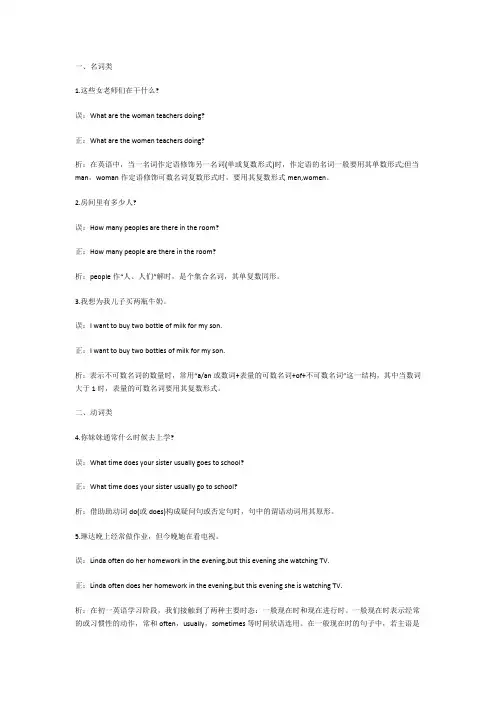
一、名词类1.这些女老师们在干什么?误:What are the woman teachers doing?正:What are the women teachers doing?析:在英语中,当一名词作定语修饰另一名词(单或复数形式)时,作定语的名词一般要用其单数形式;但当man,woman作定语修饰可数名词复数形式时,要用其复数形式men,women。
2.房间里有多少人?误:How many peoples are there in the room?正:How many people are there in the room?析:people作“人、人们”解时,是个集合名词,其单复数同形。
3.我想为我儿子买两瓶牛奶。
误:I want to buy two bottle of milk for my son.正:I want to buy two bottles of milk for my son.析:表示不可数名词的数量时,常用“a/an或数词+表量的可数名词+of+不可数名词”这一结构,其中当数词大于1时,表量的可数名词要用其复数形式。
二、动词类4.你妹妹通常什么时候去上学?误:What time does your sister usually goes to school?正:What time does your sister usually go to school?析:借助助动词do(或does)构成疑问句或否定句时,句中的谓语动词用其原形。
5.琳达晚上经常做作业,但今晚她在看电视。
误:Linda often do her homework in the evening,but this evening she watching TV.正:Linda often does her homework in the evening,but this evening she is watching TV.析:在初一英语学习阶段,我们接触到了两种主要时态:一般现在时和现在进行时。
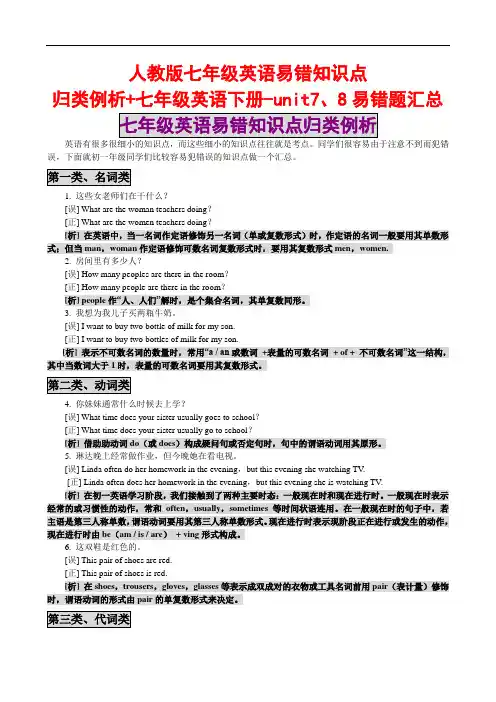
人教版七年级英语易错知识点归类例析+七年级英语下册-unit7、8易错题汇总英语有很多很细小的知识点,而这些细小的知识点往往就是考点。
同学们很容易由于注意不到而犯错误,下面就初一年级同学们比较容易犯错误的知识点做一个汇总。
1. 这些女老师们在干什么?[误] What are the woman teachers doing?[正] What are the women teachers doing?[析] 在英语中,当一名词作定语修饰另一名词(单或复数形式)时,作定语的名词一般要用其单数形式;但当man,woman作定语修饰可数名词复数形式时,要用其复数形式men,women.2. 房间里有多少人?[误] How many peoples are there in the room?[正] How many people are there in the room?[析] people作“人、人们”解时,是个集合名词,其单复数同形。
3. 我想为我儿子买两瓶牛奶。
[误] I want to buy two bottle of milk for my son.[正] I want to buy two bottles of milk for my son.[析] 表示不可数名词的数量时,常用“a / an或数词+表量的可数名词+ of + 不可数名词”这一结构,其中当数词大于1时,表量的可数名词要用其复数形式。
4. 你妹妹通常什么时候去上学?[误] What time does your sister usually goes to school?[正] What time does your sister usually go to school?[析] 借助助动词do(或does)构成疑问句或否定句时,句中的谓语动词用其原形。
5. 琳达晚上经常做作业,但今晚她在看电视。
[误] Linda often do her homework in the evening,but this evening she watching TV.[正] Linda often does her homework in the evening,but this evening she is watching TV.[析] 在初一英语学习阶段,我们接触到了两种主要时态:一般现在时和现在进行时。
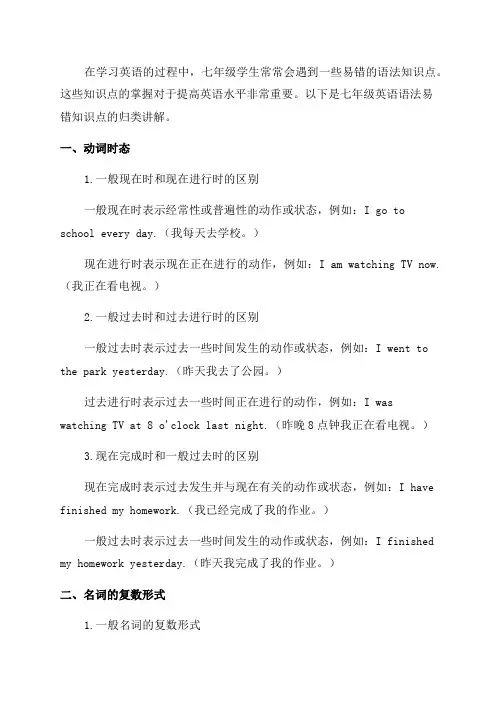
在学习英语的过程中,七年级学生常常会遇到一些易错的语法知识点。
这些知识点的掌握对于提高英语水平非常重要。
以下是七年级英语语法易错知识点的归类讲解。
一、动词时态1.一般现在时和现在进行时的区别一般现在时表示经常性或普遍性的动作或状态,例如:I go to school every day.(我每天去学校。
)现在进行时表示现在正在进行的动作,例如:I am watching TV now.(我正在看电视。
)2.一般过去时和过去进行时的区别一般过去时表示过去一些时间发生的动作或状态,例如:I went to the park yesterday.(昨天我去了公园。
)过去进行时表示过去一些时间正在进行的动作,例如:I was watching TV at 8 o'clock last night.(昨晚8点钟我正在看电视。
)3.现在完成时和一般过去时的区别现在完成时表示过去发生并与现在有关的动作或状态,例如:I have finished my homework.(我已经完成了我的作业。
)一般过去时表示过去一些时间发生的动作或状态,例如:I finished my homework yesterday.(昨天我完成了我的作业。
)二、名词的复数形式1.一般名词的复数形式一般名词变复数的规则是在词尾加-s或-es,例如:book-books(书-书籍),class-classes(班级-班级们)。
2.特殊名词的复数形式特殊名词的复数形式有一些不规则,例如:man-men(男人-男人们),woman-women(女人-女人们)。
三、冠词的使用1. 不定冠词a/an的使用不定冠词a/an用于泛指和表示一类人或物时使用,例如:I need a pen.(我需要一支钢笔。
)2. 定冠词the的使用定冠词the用于特指和已知事物时使用,例如:The book on the table is mine.(桌子上的书是我的。
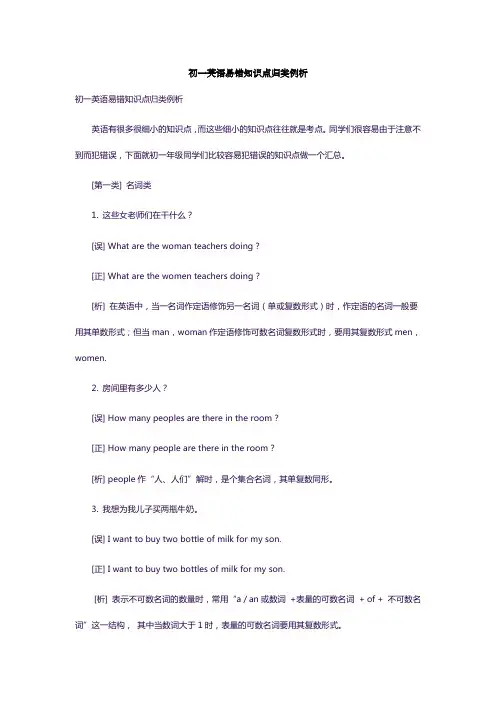
初一英语易错知识点归类例析初一英语易错知识点归类例析英语有很多很细小的知识点,而这些细小的知识点往往就是考点。
同学们很容易由于注意不到而犯错误,下面就初一年级同学们比较容易犯错误的知识点做一个汇总。
[第一类] 名词类1. 这些女老师们在干什么?[误] What are the woman teachers doing?[正] What are the women teachers doing?[析] 在英语中,当一名词作定语修饰另一名词(单或复数形式)时,作定语的名词一般要用其单数形式;但当man,woman作定语修饰可数名词复数形式时,要用其复数形式men,women.2. 房间里有多少人?[误] How many peoples are there in the room?[正] How many people are there in the room?[析] people作“人、人们”解时,是个集合名词,其单复数同形。
3. 我想为我儿子买两瓶牛奶。
[误] I want to buy two bottle of milk for my son.[正] I want to buy two bottles of milk for my son.[析] 表示不可数名词的数量时,常用“a / an或数词+表量的可数名词+ of + 不可数名词”这一结构,其中当数词大于1时,表量的可数名词要用其复数形式。
[第二类] 动词类4. 你妹妹通常什么时候去上学?[误] What time does your sister usually goes to school?[正] What time does your sister usually go to school?[析] 借助助动词do(或does)构成疑问句或否定句时,句中的谓语动词用其原形。
5. 琳达晚上经常做作业,但今晚她在看电视。
[误] Linda often do her homework in the evening,but this evening she watching TV.[正] Linda often does her homework in the evening,but this evening she is watching TV.[析] 在初一英语学习阶段,我们接触到了两种主要时态:一般现在时和现在进行时。
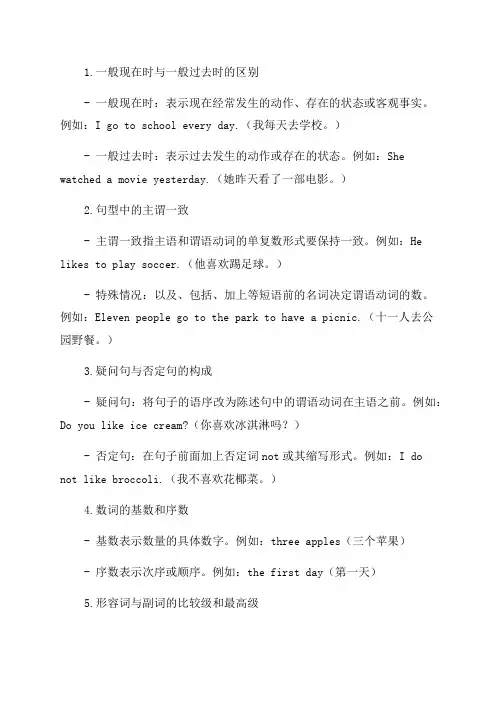
1.一般现在时与一般过去时的区别- 一般现在时:表示现在经常发生的动作、存在的状态或客观事实。
例如:I go to school every day.(我每天去学校。
)- 一般过去时:表示过去发生的动作或存在的状态。
例如:She watched a movie yesterday.(她昨天看了一部电影。
)2.句型中的主谓一致- 主谓一致指主语和谓语动词的单复数形式要保持一致。
例如:He likes to play soccer.(他喜欢踢足球。
)- 特殊情况:以及、包括、加上等短语前的名词决定谓语动词的数。
例如:Eleven people go to the park to have a picnic.(十一人去公园野餐。
)3.疑问句与否定句的构成- 疑问句:将句子的语序改为陈述句中的谓语动词在主语之前。
例如:Do you like ice cream?(你喜欢冰淇淋吗?)- 否定句:在句子前面加上否定词not或其缩写形式。
例如:I donot like broccoli.(我不喜欢花椰菜。
)4.数词的基数和序数- 基数表示数量的具体数字。
例如:three apples(三个苹果)- 序数表示次序或顺序。
例如:the first day(第一天)5.形容词与副词的比较级和最高级- 比较级:表示两个人或物之间的比较。
例如:John is taller than Mike.(约翰比迈克高。
)- 最高级:表示三个或更多人或物之间的比较。
例如:Tom is the tallest boy in his class.(汤姆是他班上最高的男孩。
)6.形容词的位置- 形容词通常放在名词之前。
例如:a beautiful house(一栋漂亮的房子)- 特殊情况:形容词修饰不可数名词时放在名词之后。
例如:a cup of hot tea(一杯热茶)7.物主代词的用法- 我的(my)、你的(your)、他的(his)、她的(her)、它的(its)、我们的(our)、你们的(your)、他们的(their)。
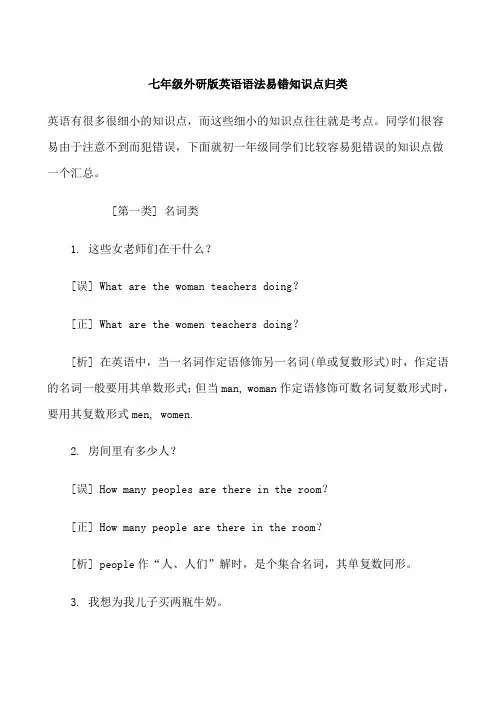
七年级外研版英语语法易错知识点归类英语有很多很细小的知识点,而这些细小的知识点往往就是考点。
同学们很容易由于注意不到而犯错误,下面就初一年级同学们比较容易犯错误的知识点做一个汇总。
[第一类] 名词类1. 这些女老师们在干什么?[误] What are the woman teachers doing?[正] What are the women teachers doing?[析] 在英语中,当一名词作定语修饰另一名词(单或复数形式)时,作定语的名词一般要用其单数形式;但当man, woman作定语修饰可数名词复数形式时,要用其复数形式men, women.2. 房间里有多少人?[误] How many peoples are there in the room?[正] How many people are there in the room?[析] people作“人、人们”解时,是个集合名词,其单复数同形。
3. 我想为我儿子买两瓶牛奶。
[误] I want to buy two bottle of milk for my son.[正] I want to buy two bottles of milk for my son.[析] 表示不可数名词的数量时,常用“a / an或数词+表量的可数名词+ of + 不可数名词”这一结构,其中当数词大于1时,表量的可数名词要用其复数形式。
[第二类] 动词类4. 你妹妹通常什么时候去上学?[误] What time does your sister usually goes to school?[正] What time does your sister usually go to school?[析] 借助助动词do(或does)构成疑问句或否定句时,句中的谓语动词用其原形。
5. 琳达晚上经常做作业,但今晚她在看电视。
[误] Linda often do her homework in the evening, but this evening she watching TV.[正] Linda often does her homework in the evening, but this evening she is watching TV.[析] 在初一英语学习阶段,我们接触到了两种主要时态:一般现在时和现在进行时。

人教版七年级英语易错知识点归类例析+七年级英语下册-unit7、8易错题汇总英语有很多很细小的知识点,而这些细小的知识点往往就是考点。
同学们很容易由于注意不到而犯错误,下面就初一年级同学们比较容易犯错误的知识点做一个汇总。
1. 这些女老师们在干什么?[误] What are the woman teachers doing?[正] What are the women teachers doing?[析] 在英语中,当一名词作定语修饰另一名词(单或复数形式)时,作定语的名词一般要用其单数形式;但当man,woman作定语修饰可数名词复数形式时,要用其复数形式men,women.2. 房间里有多少人?[误] How many peoples are there in the room?[正] How many people are there in the room?[析] people作“人、人们”解时,是个集合名词,其单复数同形。
3. 我想为我儿子买两瓶牛奶。
[误] I want to buy two bottle of milk for my son.[正] I want to buy two bottles of milk for my son.[析] 表示不可数名词的数量时,常用“a / an或数词+表量的可数名词+ of + 不可数名词”这一结构,其中当数词大于1时,表量的可数名词要用其复数形式。
4. 你妹妹通常什么时候去上学?[误] What time does your sister usually goes to school?[正] What time does your sister usually go to school?[析] 借助助动词do(或does)构成疑问句或否定句时,句中的谓语动词用其原形。
5. 琳达晚上经常做作业,但今晚她在看电视。
[误] Linda often do her homework in the evening,but this evening she watching TV.[正] Linda often does her homework in the evening,but this evening she is watching TV.[析] 在初一英语学习阶段,我们接触到了两种主要时态:一般现在时和现在进行时。
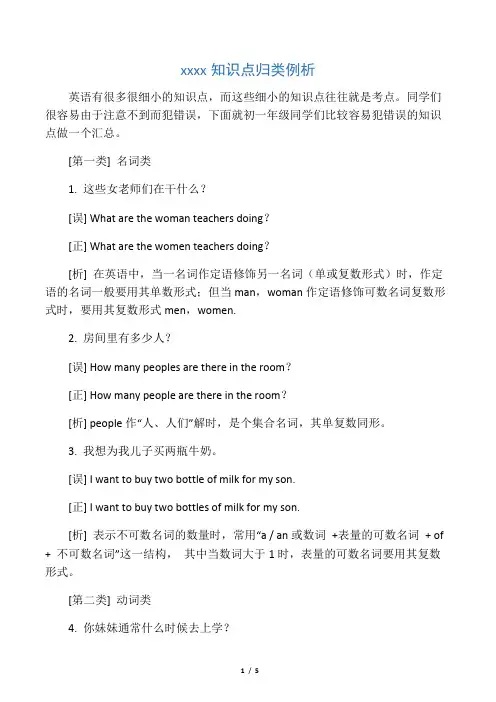
xxxx知识点归类例析英语有很多很细小的知识点,而这些细小的知识点往往就是考点。
同学们很容易由于注意不到而犯错误,下面就初一年级同学们比较容易犯错误的知识点做一个汇总。
[第一类] 名词类1. 这些女老师们在干什么?[误] What are the woman teachers doing?[正] What are the women teachers doing?[析] 在英语中,当一名词作定语修饰另一名词(单或复数形式)时,作定语的名词一般要用其单数形式;但当man,woman作定语修饰可数名词复数形式时,要用其复数形式men,women.2. 房间里有多少人?[误] How many peoples are there in the room?[正] How many people are there in the room?[析] people作“人、人们”解时,是个集合名词,其单复数同形。
3. 我想为我儿子买两瓶牛奶。
[误] I want to buy two bottle of milk for my son.[正] I want to buy two bottles of milk for my son.[析] 表示不可数名词的数量时,常用“a / an或数词+表量的可数名词+ of + 不可数名词”这一结构,其中当数词大于1时,表量的可数名词要用其复数形式。
[第二类] 动词类4. 你妹妹通常什么时候去上学?[误] What time does your sister usually goes to school?[正] What time does your sister usually go to school?[析] 借助助动词do(或does)构成疑问句或否定句时,句中的谓语动词用其原形。
5. 琳达晚上经常做作业,但今晚她在看电视。
[误] Linda often do her homework in the evening,but this evening she watching TV.[正] Linda often does her homework in the evening,but this evening she is watching TV.[析] 在初一英语学习阶段,我们接触到了两种主要时态:一般现在时和现在进行时。
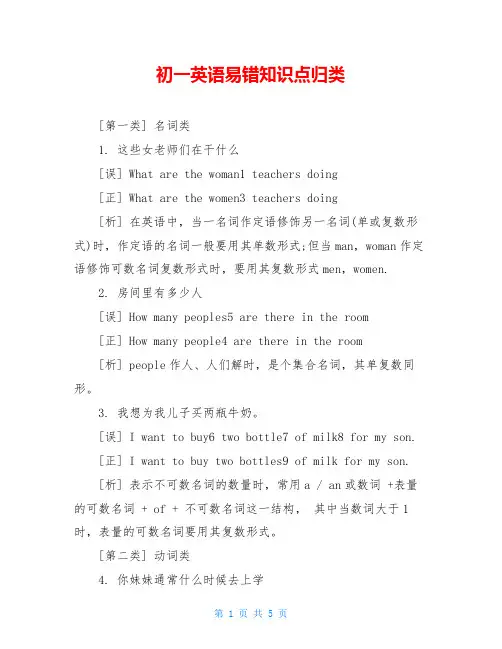
初一英语易错知识点归类[第一类] 名词类1. 这些女老师们在干什么[误] What are the woman1 teachers doing[正] What are the women3 teachers doing[析] 在英语中,当一名词作定语修饰另一名词(单或复数形式)时,作定语的名词一般要用其单数形式;但当man,woman作定语修饰可数名词复数形式时,要用其复数形式men,women.2. 房间里有多少人[误] How many peoples5 are there in the room[正] How many people4 are there in the room[析] people作人、人们解时,是个集合名词,其单复数同形。
3. 我想为我儿子买两瓶牛奶。
[误] I want to buy6 two bottle7 of milk8 for my son.[正] I want to buy two bottles9 of milk for my son.[析] 表示不可数名词的数量时,常用a / an或数词 +表量的可数名词 + of + 不可数名词这一结构,其中当数词大于1时,表量的可数名词要用其复数形式。
[第二类] 动词类4. 你妹妹通常什么时候去上学[误] What time does your sister10 usually11 goes to school[正] What time does your sister usually go to school [析] 借助助动词do(或does)构成疑问句或否定句时,句中的谓语动词用其原形。
5. 琳达晚上经常做作业,但今晚她在看电视。
[误] Linda often do her homework12 in the evening,but this evening she watching13 TV.[正] Linda often does her homework in the evening,but this evening she is watching TV.[析] 在初一英语学习阶段,我们接触到了两种主要时态:一般现在时和现在进行时。
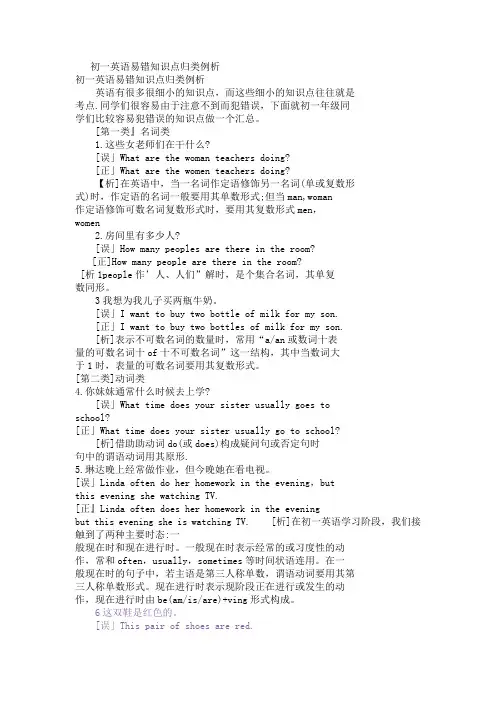
初一英语易错知识点归类例析初一英语易错知识点归类例析英语有很多很细小的知识点,而这些细小的知识点往往就是考点.同学们很容易由于注意不到而犯错误,下面就初一年级同学们比较容易犯错误的知识点做一个汇总。
[第一类』名词类1.这些女老师们在干什么?[误」What are the woman teachers doing?[正」What are the women teachers doing?【析]在英语中,当一名词作定语修饰另一名词(单或复数形式)时,作定语的名词一般要用其单数形式;但当man,woman作定语修饰可数名词复数形式时,要用其复数形式men,women2.房间里有多少人?[误」How many peoples are there in the room?[正]How many people are there in the room?[析1people作’人、人们”解时,是个集合名词,其单复数同形。
3我想为我儿子买两瓶牛奶。
[误」I want to buy two bottle of milk for my son.[正」I want to buy two bottles of milk for my son.[析]表示不可数名词的数量时,常用“a/an或数词十表量的可数名词十of十不可数名词”这一结构,其中当数词大于1时,表量的可数名词要用其复数形式。
[第二类]动词类4.你妹妹通常什么时候去上学?[误」What time does your sister usually goes toschool?[正」What time does your sister usually go to school?[析]借助助动词do(或does)构成疑问句或否定句时句中的谓语动词用其原形.5.琳达晚上经常做作业,但今晚她在看电视。
[误」Linda often do her homework in the evening,butthis evening she watching TV.[正』Linda often does her homework in the eveningbut this evening she is watching TV. [析]在初一英语学习阶段,我们接触到了两种主要时态:一般现在时和现在进行时。

初一英语语法易错知识点归类例析英语有很多很细小的知识点,而这些细小的知识点往往就是考点。
同学们很容易由于注意不到而犯错误,下面就初一年级同学们比较容易犯错误的知识点做一个汇总。
[第一类] 名词类1. 这些女老师们在干什么?[误] What are the woman teachers doing?[正] What are the women teachers doing?[析] 在英语中,当一名词作定语修饰另一名词(单或复数形式)时,作定语的名词一般要用其单数形式;但当man,woman作定语修饰可数名词复数形式时,要用其复数形式men,women.2. 房间里有多少人?[误] How many peoples are there in the room?[正] How many people are there in the room?[析] people作“人、人们”解时,是个集合名词,其单复数同形。
3. 我想为我儿子买两瓶牛奶。
[误] I want to buy two bottle of milk for my son.[正] I want to buy two bottles of milk for my son.[析] 表示不可数名词的数量时,常用“a / an或数词+表量的可数名词+ of + 不可数名词”这一结构,其中当数词大于1时,表量的可数名词要用其复数形式。
[第二类] 动词类4. 你妹妹通常什么时候去上学?[误] What time does your sister usually goes to school?[正] What time does your sister usually go to school?[析] 借助助动词do(或does)构成疑问句或否定句时,句中的谓语动词用其原形。
5. 琳达晚上经常做作业,但今晚她在看电视。
[误] Linda often do her homework in the evening,but this evening she watching TV.[正] Linda often does her homework in the evening,but this evening she is watching TV. [析] 在初一英语学习阶段,我们接触到了两种主要时态:一般现在时和现在进行时。
初一语法易混淆点解析语言是人类交流的工具,准确使用语法规则是确保交流效果的重要一环。
然而,初学者常常面临语法易混淆点的困扰。
本文将针对初一学生常见的语法易混淆点进行解析,帮助学生更好地掌握语言规则。
一、动词时态的正确运用动词时态是一个常见的易混淆点,主要表现在一般过去时和现在完成时的使用上。
1. 一般过去时(Simple Past Tense)一般过去时用于表示过去发生的动作或状态,常常和过去的时间状语连用。
例如:- 我昨天去了图书馆。
(I went to the library yesterday.)- 她在学校学习了三年英语。
(She studied English for three years in school.)2. 现在完成时(Present Perfect Tense)现在完成时用于表示过去发生的与现在有关的动作或状态,常常和包含“已经”、“曾经”等词语的时间状语连用。
例如:- 我已经看过这部电影了。
(I have watched this movie.)- 他曾经去过中国。
(He has been to China.)正确运用动词时态可以提高句子的准确度和流畅度,避免语法错误。
二、冠词的选择冠词是名词前面的限定词,包括定冠词(the)、不定冠词(a/an)及零冠词。
初一学生常常在选择冠词时容易混淆。
1. 定冠词(the)定冠词用于特指某一事物,表示已知的或特定的对象。
例如:- 请递给我那本书。
(Please give me the book.)- 那个男孩是我的朋友。
(The boy is my friend.)2. 不定冠词(a/an)不定冠词用于泛指事物,表示非特定的或未知的对象。
例如:- 我看到了一只小猫。
(I saw a cat.)- 他买了一本新书。
(He bought a new book.)正确选择冠词可以准确表达句子的意思,增强语言的准确性。
三、代词的使用代词是用来代替名词的词语,可以避免重复使用同一名词,提高语言的流畅度。
初一英语易错知识点归类例析英语有很多很细小的知识点,而这些细小的知识点往往就是考点。
同学们很容易由于注意不到而犯错误,下面就初一年级同学们比较容易犯错误的知识点做一个汇总。
[第一类] 名词类1. 这些女老师们在干什么?[误] What are the woman teachers doing?[正] What are the women teachers doing?[析] 在英语中,当一名词作定语修饰另一名词(单或复数形式)时,作定语的名词一般要用其单数形式;但当man,woman作定语修饰可数名词复数形式时,要用其复数形式men,women.2. 房间里有多少人?[误] How many peoples are there in the room?[正] How many people are there in the room?[析] people作“人、人们”解时,是个集合名词,其单复数同形。
3. 我想为我儿子买两瓶牛奶。
第 1 页共6 页[误] I want to buy two bottle of milk for my son.[正] I want to buy two bottles of milk for my son.[析] 表示不可数名词的数量时,常用“a / an或数词+表量的可数名词+ of + 不可数名词”这一结构,其中当数词大于1时,表量的可数名词要用其复数形式。
[第二类] 动词类4. 你妹妹通常什么时候去上学?[误] What time does your sister usually goes to school?[正] What time does your sister usually go to school?[析] 借助助动词do(或does)构成疑问句或否定句时,句中的谓语动词用其原形。
5. 琳达晚上经常做作业,但今晚她在看电视。
[误] Linda often do her homework in the evening,but this evening she watching TV.[正] Linda often does her homework in the evening,but this evening she is watching TV.第 2 页共6 页[析] 在初一英语学习阶段,我们接触到了两种主要时态:一般现在时和现在进行时。
英语语法是学生学习中常见的难点之一,尤其对于七年级的初学者来说。
以下是一些七年级英语语法中常见的易错知识点的归类讲解。
一、名词1.可数名词与不可数名词的区别可数名词是指可以数出来的人或物,如cat、apple。
不可数名词则是不能够数出来的,如water、milk。
在使用时要注意可数名词要有对应的数词或者冠词,而不可数名词通常不与数词连用。
2.单数和复数形式名词的单数和复数形式在拼写上有规则可循,一般在名词后面加-s 或-es来表示复数。
但也有一些名词的复数形式需要特殊变化,如man-men、child-children等,需要记忆和辨析。
3.可数名词与不可数名词的使用在表达数量时,可数名词可用于表示单位或具体数量,而不可数名词一般只能用量词来修饰,如a cup of water。
在表达情感、抽象概念等时,不可数名词常被使用。
二、冠词1. 不定冠词a/an的使用不定冠词a/an用于表示泛指的情况,表示“一个”的意思。
它的使用需要根据名词的首字母来决定使用a还是an,如an apple、a book。
需要注意的是,当名词以元音音素开头时使用an,其他情况使用a。
2. 定冠词the的使用定冠词the用于特指一些人或物,在句子中表示已知或特定的事物。
用法较为固定,需要注意冠词的使用。
三、形容词1.形容词的比较级和最高级形容词的比较级和最高级分别表示不同程度的描述,比较级表示两者之间的比较,最高级表示三者或三者以上的比较。
在使用时需要掌握规则变化和特殊情况,如辅音字母结尾双写加-er和-est等。
2.形容词的位置形容词通常位于名词之前修饰名词,但也有一些形容词可以放在名词后面修饰,如something interesting。
四、动词1.动词的时态动词的时态分为一般现在时、一般过去时和一般将来时等,需要根据句意和上下文语境来确定使用何种时态。
需要注意的是,不同的时态表示不同时期的动作或状态。
2.动词的第三人称单数形式动词的第三人称单数形式在一般现在时中使用,通常在动词尾部加-s,如he speaks、she dances。
一、动词时态1.一般现在时:表示经常或习惯性的动作、普遍真理、客观事实等。
常见错误:错误1:She has a lot of friends. (误用了一般现在时)正确:She has a lot of friends.2.现在进行时:表示现在正在进行的动作。
常见错误:错误1:I go to school now. (误用了现在进行时)正确:I am going to school now.错误2:He is studying the English now. (不可与现在进行时连用的时间状语)正确:He is studying English now.3.一般过去时:表示过去一些时间发生的动作或状态。
常见错误:错误1:I go to Beijing last summer. (误用了一般过去时)正确:I went to Beijing last summer.错误2:The sun is rose at 6 o'clock yesterday. (错误的过去时的用法)正确:The sun rose at 6 o'clock yesterday.4.过去进行时:表示过去一些时间正在进行的动作。
常见错误:错误1:I worked in the garden at 6 o'clock yesterday. (误用了过去进行时)正确:I was working in the garden at 6 o'clock yesterday.错误2:She watched TV at 7 p.m. yesterday. (将一般过去时和过去进行时混合使用)正确:She was watching TV at 7 p.m. yesterday.二、名词单复数1. 一般情况下,名词的复数形式在末尾加-s或-es。
常见错误:错误1:The childs are playing in the park. (误用了名词的复数形式)正确:The children are playing in the park.错误2:The boxs is on the table. (误用了名词的复数形式)正确:The boxes are on the table.2. 以辅音字母+y结尾的名词,变复数时,变y为i,再加-es。
初一英语语法易错知识点归类例析
英语有很多很细小的知识点,而这些细小的知识点往往就是考点。
同学们很容易由于注意不到而犯错误,下面就初一年级同学们比较容易犯错误的知识点做一个汇总。
[第一类] 名词类
1. 这些女老师们在干什么?
[误] What are the woman teachers doing?
[正] What are the women teachers doing?
[析] 在英语中,当一名词作定语修饰另一名词(单或复数形式)时,作定语的名词一般要用其单数形式;但当man, woman作定语修饰可数名词复数形式时,要用其复数形式men, women.
2. 房间里有多少人?
[误] How many peoples are there in the room?
[正] How many people are there in the room?
[析] people作“人、人们”解时,是个集合名词,其单复数同形。
3. 我想为我儿子买两瓶牛奶。
[误] I want to buy two bottle of milk for my son.
[正] I want to buy two bottles of milk for my son.
[析] 表示不可数名词的数量时,常用“a / an或数词+表量的可数名词+ of + 不可数名词”这一结构,其中当数词大于1时,表量的可数名词要用其复数形式。
[第二类] 动词类
4. 你妹妹通常什么时候去上学?
[误] What time does your sister usually goes to school?
[正] What time does your sister usually go to school?
[析] 借助助动词do(或does)构成疑问句或否定句时,句中的谓语动词用其原形。
5. 琳达晚上经常做作业,但今晚她在看电视。
[误] Linda often do her homework in the evening, but this evening she watching TV.
[正] Linda often does her homework in the evening, but this evening she is watching TV.
[析] 在初一英语学习阶段,我们接触到了两种主要时态:一般现在时和现在进行时。
一般现在
时表示经常的或习惯性的动作,常和often, usually, sometimes 等时间状语连用。
在一般现在时的句子中,若主语是第三人称单数,谓语动词要用其第三人称单数形式。
现在进行时表示现阶段正在进行或发生的动作,现在进行时由be(am / is / are)+ving形式构成。
6. 这双鞋是红色的。
[误] This pair of shoes are red.
[正] This pair of shoes is red.
[析] 在shoes, trousers, gloves, glasses等表示成双成对的衣物或工具名词前用pair(表计量)修饰时,谓语动词的形式由pair的单复数形式来决定。
[第三类] 代词类
7. 这张票是她的,不是我的。
[误] This is hers ticket. It’s not my.
[正] This is her ticket. It’s not mine.
[析] 物主代词有形容词性物主代词和名词性物主代词之分。
形容词性物主代词之后一定要接名词,而名词性物主代词之后不需接任何词。
8. 吴老师教我们英语。
[误] Miss Wu teaches our English.
[正] Miss Wu teaches us English.
[析] teach sb. sth..中的sb.作teach的宾语,因此当sb.为人称代词时要用其宾格形式。
第四类] 介词类
9. 你能找到这个问题的答案吗?
[误] Can you find the answer of this question?
[正] Can you find the answer to this question?
[析] 英语中用“the answer to …”表示“……的答案”。
类似结构还有the key to the door, the way to the zoo等。
10. 格林先生星期六上午来这里。
[误] Mr. Green will come here in Sunday evening.
[正] Mr. Green will come here on Sunday evening.
[析] 表示在上午、下午等时,介词要用in;而表示在具体的某天上午、下午时,介词要用on.
11. 那个穿着红裙子的小女孩是我们老师的女儿。
[误] That little girl on a red skirt is our teacher’s daughter.
[正] That little girl in a red skirt is our teacher’s daughter.
[析] 用介词表示“穿戴衣物”时,只能用in,其他介词没有此用法。
[第五类] 副词类
12. 莉莉,你为什么不回家呢?
[误] Lily, why don’t you go to home?
[正] Lily, why don’t you go home?
[析] come, go 等后接here, there, home等地点副词时,地点副词前不加to。
[第六类] 连词类
13. 我喜欢语文和英语,但我不喜欢体育和历史。
[误] I like Chinese and English, but I don’t like P.E. and history.
[正] I like Chinese and English, but I don’t like P.E. or history.
[析] 在肯定句中并列成分之间用and来连接;而在否定句中,并列成分之间的连接需用or。
[第七类] 冠词类
14. 乘飞机去北京花了史密斯一家人一个小时。
[误] It takes Smiths a hour to go to Beijing by a plane.
[正] It takes the Smiths an hour to go to Beijing by plane.
[析] 1.表示“……一家人”用结构“the + 姓氏复数”;
2.our 一词的第一个字母不发音,它是以元音音素开头的,所以“一小时”要用 an hour;
3.用介词by表示“乘坐”某种交通工具时,交通工具名词前不加任何冠词。
[第八类] 句法类
15. ――你不是学生吗?――不,我是学生。
[误] ――Aren’t you a student?――No, I am.
[正] ――Aren’t you a student?――Yes, I am.
[析] 对否定疑问句的回答是用Yes还是用No,这取决于实际情况:如果事实是肯定
的,就用Yes表“不”;如果事实是否定的,就用No表“是的”。
2. 房间里有多少人?
[误] How many peoples are there in the room?
[正] How many people are there in the room?
[析] people作“人、人们”解时,是个集合名词,其单复数同形。